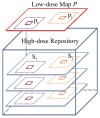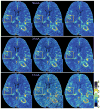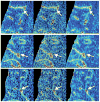Improving low-dose blood-brain barrier permeability quantification using sparse high-dose induced prior for Patlak model
- PMID: 24200529
- PMCID: PMC4188431
- DOI: 10.1016/j.media.2013.09.008
Improving low-dose blood-brain barrier permeability quantification using sparse high-dose induced prior for Patlak model
Abstract
Blood-brain barrier permeability (BBBP) measurements extracted from the perfusion computed tomography (PCT) using the Patlak model can be a valuable indicator to predict hemorrhagic transformation in patients with acute stroke. Unfortunately, the standard Patlak model based PCT requires excessive radiation exposure, which raised attention on radiation safety. Minimizing radiation dose is of high value in clinical practice but can degrade the image quality due to the introduced severe noise. The purpose of this work is to construct high quality BBBP maps from low-dose PCT data by using the brain structural similarity between different individuals and the relations between the high- and low-dose maps. The proposed sparse high-dose induced (shd-Patlak) model performs by building a high-dose induced prior for the Patlak model with a set of location adaptive dictionaries, followed by an optimized estimation of BBBP map with the prior regularized Patlak model. Evaluation with the simulated low-dose clinical brain PCT datasets clearly demonstrate that the shd-Patlak model can achieve more significant gains than the standard Patlak model with improved visual quality, higher fidelity to the gold standard and more accurate details for clinical analysis.
Keywords: Blood–brain barrier permeability; Patlak model; Radiation dose reduction; Sparse high-dose induced prior.
Copyright © 2013 Elsevier B.V. All rights reserved.
Figures










Similar articles
-
Optimal duration of acquisition for dynamic perfusion CT assessment of blood-brain barrier permeability using the Patlak model.AJNR Am J Neuroradiol. 2009 Aug;30(7):1366-70. doi: 10.3174/ajnr.A1592. Epub 2009 Apr 15. AJNR Am J Neuroradiol. 2009. PMID: 19369610 Free PMC article.
-
Dynamic perfusion CT assessment of the blood-brain barrier permeability: first pass versus delayed acquisition.AJNR Am J Neuroradiol. 2008 Oct;29(9):1671-6. doi: 10.3174/ajnr.A1203. Epub 2008 Jul 17. AJNR Am J Neuroradiol. 2008. PMID: 18635616 Free PMC article.
-
Accuracy and anatomical coverage of perfusion CT assessment of the blood-brain barrier permeability: one bolus versus two boluses.Cerebrovasc Dis. 2008;26(6):600-5. doi: 10.1159/000165113. Epub 2008 Oct 23. Cerebrovasc Dis. 2008. PMID: 18946215 Free PMC article.
-
Radiation dose reduction in perfusion CT imaging of the brain: A review of the literature.J Neuroradiol. 2016 Feb;43(1):1-5. doi: 10.1016/j.neurad.2015.06.003. Epub 2015 Dec 10. J Neuroradiol. 2016. PMID: 26452610 Review.
-
Basics of iterative reconstruction methods in computed tomography: A vendor-independent overview.Eur J Radiol. 2018 Dec;109:147-154. doi: 10.1016/j.ejrad.2018.10.025. Epub 2018 Oct 26. Eur J Radiol. 2018. PMID: 30527298 Review.
Cited by
-
TENDER: Tensor non-local deconvolution enabled radiation reduction in CT perfusion.Neurocomputing (Amst). 2017 Mar 15;229:13-22. doi: 10.1016/j.neucom.2016.03.109. Epub 2016 Nov 17. Neurocomputing (Amst). 2017. PMID: 32523255 Free PMC article.
-
Robust Low-Dose CT Perfusion Deconvolution via Tensor Total-Variation Regularization.IEEE Trans Med Imaging. 2015 Jul;34(7):1533-1548. doi: 10.1109/TMI.2015.2405015. Epub 2015 Feb 20. IEEE Trans Med Imaging. 2015. PMID: 25706579 Free PMC article.
References
-
- Andersen I, Szymkowiak A, Rasmussen C, Hanson L, Marstrand J, Larsson H, Hansen L. Perfusion quantification using Gaussian process deconvolution. Magnetic Resonance in Medicine. 2002;48:351–361. - PubMed
-
- Bisdas S, Hartel M, Cheong L, Koh T, Vogl T. Prediction of subsequent hemorrhage in acute ischemic stroke using permeability CT imaging and a distributed parameter tracer kinetic model. Journal of neuroradiology. 2007;34:101–108. - PubMed
-
- Britten A, Crotty M, Kiremidjian H, Grundy A, Adam E. The addition of computer simulated noise to investigate radiation dose and image quality in images with spatial correlation of statistical noise: an example application to X-ray CT of the brain. British journal of radiology. 2004;77:323–328. - PubMed
-
- Calamante F, Gadian D, Connelly A. Quantification of bolus-tracking MRI: Improved characterization of the tissue residue function using Tikhonov regularization. Magnetic resonance in medicine. 2003;50:1237–1247. - PubMed
Publication types
MeSH terms
Grants and funding
LinkOut - more resources
Full Text Sources
Other Literature Sources
Medical

